The annual Tram Weekend at the Crich Tramway Village took place on Saturday 13th and Sunday 14th September and once again the team at the home of the National Tramway Museum managed to put an excellent show with trams in service and the famous photo line-ups on the depot fan combining for an entertaining two days showcasing tram preservation in the UK.
Trams in service
Over the two days of the weekend, 16 different passenger trams ran in service – nine on the first day and ten on Sunday 14th September.
One of the highlights of the trams in service was the return to service of Blackpool & Fleetwood 40, rather apt as one of the celebrations during the weekend was the 140th anniversary of the opening of the Blackpool Tramway in 1885, for the first time since 2022.
40 missed the entirety of the 2023 and 2024 seasons but recent work on the tram has meant it is now operational again and it made its first appearance in passenger service on day one of the event, Saturday 13th September 2025.
40 was one of just three trams to be used on both days with London County Council 1 (itself only returning to service last year after its major restoration) and London County Council 106 the others.
In addition to the passenger trams two works cars were seen out on the mainline, offering rides to a lucky few passengers on trips up to Glory Mine. Cardiff 131 was used on both days whilst the Blackpool Electric Locomotive was out on just Saturday 13th with it being displayed on the depot fan on Sunday 14th.
London County Council 1 both started and ended the weekends passenger rides with it forming (along with fellow LCC car, 106) a 1030 departure on Saturday 13th with it then running a 1700 service on Sunday 14th. Sadly the weather on the Sunday afternoon had meant that by this time there weren’t too many visitors left on site with heavy downpours leading to many deciding to leave early. This had also seen Blackpool 236, LCC 106, Newcastle 102, Chesterfield 7 and Sheffield 510 all head back to depot earlier than they might have.
Saturday 13th September: London County Council 1, Glasgow 22, Blackpool & Fleetwood 40, Sheffield 74, London County Council 106, Oporto 273, Leeds 345, Leeds 399, London Transport 1622 plus works cars Cardiff 131, Blackpool Electric Locomotive
Sunday 14TH September: London County Council 1, Chesterfield 7, Blackpool 40, Blackpool & Fleetwood 40, Newcastle 102, London County Council 106, Blackpool 167, Blackpool 236, Sheffield 510, Blackpool 630 plus works car Cardiff 131
Depot Fan line-ups
The depot fan is where it all happens over the course of a Tram Weekend with various themes of line-ups and the chance to see some trams which are usually displayed in the Exhibition Hall or stored in the depots outside, and 2025 was no different!
Saturday 13th saw two main themes on the depot fan with the first chance taken to show-off the newest acquisitions at Crich – the three trams donated to the TMS by the Merseyside Tramway Preservation Society. Wallasey 78, Liverpool 762 and Birkenhead 20 (none of which are currently operational) were dragged out of their homes in the depots and put in a line in front of the Traverser (with 20 on the Traverser itself). They were joined by another tram from Merseyside with long-time Crich resident Liverpool 869 (which is also not operational in 2025).
Meanwhile, over the other side of the fan it was London that was the theme with currently out of service Metropolitan Electric Tramways 331 pulled out from the back of the depot to go on display. Then as lunch came it was joined by three other London trams – all of which were running in service – as London County Council pair 1 and 106 as well as London Transport 1622 came back for a break. The Croydon Tramlink KLV 058 and its trailer 061 were also on the centre stub track.
A further line-up was also former in front of the depot with the three Leeds double deckers on display. 180 (another out of service for 2025 tram) was joined by 345 and 399 which were in service on the first day.
Then on Sunday 14th it was the time for Blackpool to take centre stage as Crich helped the tramway to celebrate its 140th anniversary with no fewer than 11 trams from the Fylde Coast being lined-up at various times during the day.
This included five trams which are not part of the current operational fleet: Rack 2, Conduit 4 (although this has to be shunted back into the depot when the rains came), Standard 49, Toastrack 166 and Jubilee 762. The Electric Locomotive was also stabled on the fan for much of the day and at various times during the day as tram crews were taking breaks Box 40, Standard 40, Pantograph 167, Boat 236 (which because of the weather didn’t return to service after coming for display) and Brush 630 all came and were lined-up with other trams from Blackpool. Amongst the highlights of the line-ups was the chance to see Conduit 4 and Jubilee 762 side-by-side – the complete evolution of the Blackpool double decker!
Merseyside wasn’t forgotten either with Wallasey 78, Liverpool 762 and Liverpool 869 all out again, and in different positions from the previous day. This also allowed the two 762s to be displayed together during the day.
Saturday 13th September line-ups:
Merseyside: Birkenhead 20, Wallasey 78, Liverpool 762, Liverpool 869
London: London County Council 1, London County Council 106, Metropolitan Electric Tramways 331, London Transport 1622, Croydon Tramlink 058+061
Leeds: 180, 345, 399
Sunday 14th September line-ups:
Merseyside: Wallasey 78, Liverpool 762, Liverpool 869
Blackpool: 2, 4, Box 40, Standard 40, 49, 166, 167, 236, 630, 762, Electric Locomotive
Curtain Raisers
Both days also saw Curtain Raiser photo opportunities in the museum street. Saturday 13th saw a London theme as London County Council 1 and 106 were displayed at Stephenson Place before running the first trip of the day.
Sunday 14th was due to see a Blackpool tram theme but as public transport on a Sunday doesn’t allow you to get to Crich at museum opening time what trams they were is unknown. If anyone out there can update us. please do so in the comments below!
Saturday 13th Curtain Raiser: London County Council 1 and London County Council 106
Other Shunting
In order for some of the rarer trams to be displayed during the event it meant that some others had to be shunted out of the way.
This included Southampton 45 – the tram which started the TMS when purchased back in 1948 – which was moved from the Exhibition Hall on the Saturday into the depot and then put back to the Exhibition Hall on the Sunday.
Johannesburg 60 was also seen having been moved into the Workshop on Sunday 14th.
Other attractions
Both days also saw behind the scenes tours of the Workshop where progress could be seen on two major projects – the conversion of Blackpool Centenary 645 to a new Access Tram and the major restoration of Blackpool Brush 298.
It wasn’t all just about the trams either! Both days saw a spectacular fly-past. Saturday 13th saw a Lancaster Bomber fly over the museum whilst the morning of Sunday 14th (before the rain came!) saw a Spitfire also fly overhead at the museum.
Saturday also saw music on the Bandstand but sadly the weather put paid to a repeat on the Sunday.
All in all it was another hugely enjoyable Tram Weekend at Crich. Plenty of trams to ride on and even more trams to take photos of with the photo line-ups being unrepeatable anywhere else within the UK. Don’t forget events like this are only made possible thanks to the volunteers who give up their spare time – like most heritage organisations Crich are always on the lookout for more volunteers, find out more online at https://www.tramway.co.uk/contact/volunteering/.
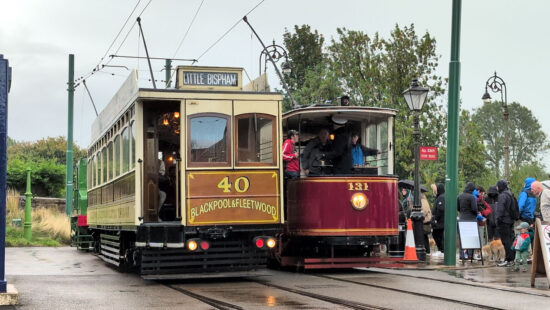
Blackpool & Fleetwood Box 40 made a welcome return to service on Saturday 13th September and is seen here preparing to depart from Town End with Cardiff 131 next to it and the Blackpool Electric Locomotive behind.
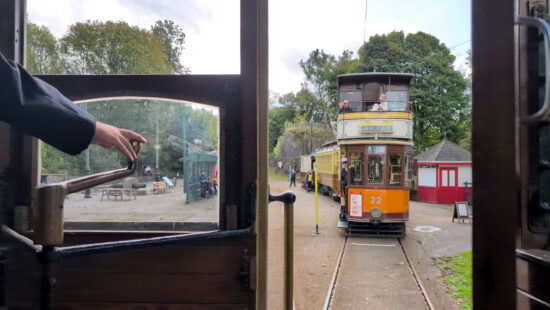
A stunning shot through the front door of 40 as it arrives at Wakebridge where Glasgow 22, Oporto 273 and Cardiff 131 are waiting.
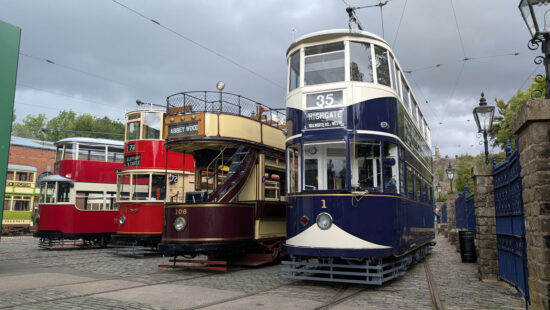
Depot fan on Saturday 13th with a quarter of London trams. From right to left we have LCC 1, LCC 106, LT 1622 and MET 331.
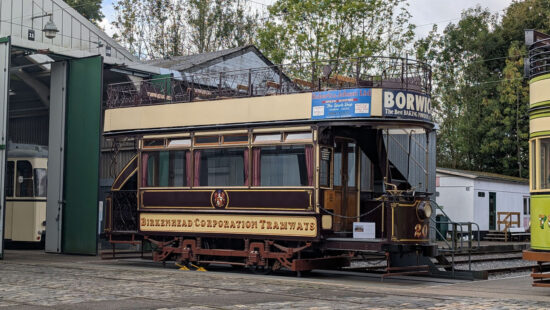
Birkenhead 20 was displayed on the Traverser on Saturday 13th and this image shows its posing for photos.
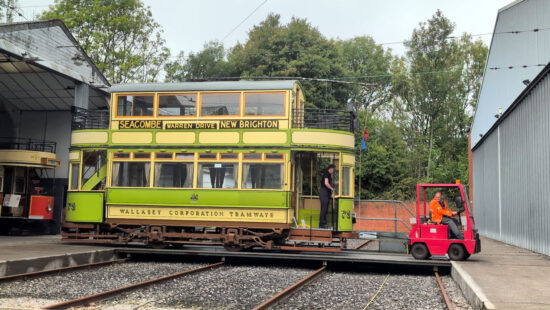
The trio of new arrivals is completed by Wallasey 78 which is seen taking a ride on the Traverser on Sunday 14th.
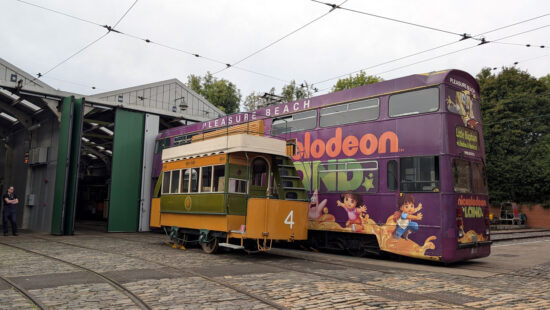
The complete evolution of the Blackpool double-decker? Whilst the rebuilt flat fronted Balloon Cars (Millennium Cars) could lay a claim to being the end of the double decker, the design of the Jubilee introducing driver only operational is probably more significant and 762 is seen here alongside Conduit 4. The initial build of these two trams is actually less than 50 years (with 762 originally being a Balloon of course) but the huge size difference is clear to be seen!

Spitfire flypast with the plane caught coming over the Museum in between Liverpool 869 and Blackpool 49.

This is less than half of the Blackpool trams which featured during line-ups on the fan. Box 40, Rack 2, Toastrack 166, Standard 40 and Standard 49.

Inside the Workshop and excellent progress is already being made on stripping Centenary 645 ahead of its conversation to the new Access Tram. (All Photographs by Steven Hughes)
- There will plenty more coverage to come from Tram Weekend on British Trams Online in due course.

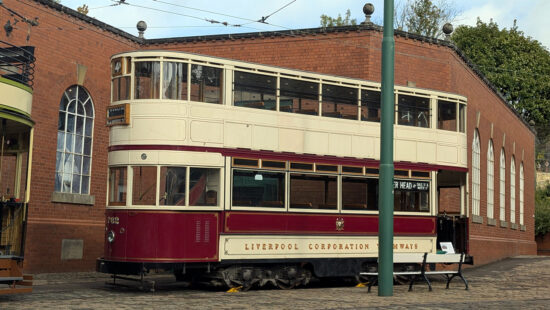
What a brilliant event that was! I think it was a near-perfect balance between stuff to keep enthusiasts happy and entertaining the general public. There was a really good atmosphere as well, no miserable people moaning when a child walks in front of their camera; no doubt having the main lineups remain in place throughout the day helped as you could have multiple attempts at getting photos.
I was only there on Saturday but personal highlights were the stunning Merseyside lineup, seeing Blackpool Conduit car 4 being moved across the depot fan at the end of the day (an unexpected bonus as it was being moved ready for its starring role the following day) and a ride on Box 40. Sunday’s Blackpool lineups looked spectacular as well, particularly 4 posed next to 762, and 762 with the other 762 of course!
It was a shame the weather wasn’t better but event-wise I’d say this was better than last year, everyone involved should be very proud of themselves for putting on such a good show in some challenging conditions. I hope future events follow a similar pattern as the format was very good!
I was really disappointed about one thing, the very low enthusiast turnout. If the ‘Tram Fans’ spent as much time and effort in supporting as they do whingeing online, the future of preservation would look much more secure than it does now.
You are assuming every single Tram enthusiast can actually attend one or two days a year?
You are assuming they are able bodies, not working and don’t have any other commitments?
Or maybe enthusiasm in general is waning?
Maybe people have seen and done it all before and there is little new to interest them?
Not just at Crich but in general.
To be honest, I think quite a few enthusiasts have turned their backs on the hobby in the last 5 years or so. I guess Covid probably meant that people got out of the habit of attending tram events and never fully got back into it, but also, I know a lot of younger enthusiasts were mainly interested in Blackpool trams. The downfall of Blackpool heritage seems to have resulted in a fair few of them turning their back on trams altogether – which I think is a real shame, as there’s still plenty to enjoy!
On Saturday the museum was VERY busy though, with big queues for tram rides and a full car park. A good mix of people seemed to be enjoying themselves, ranging from people with expensive cameras to families with very young children. I’d say if an event manages to entertain such a wide range of people, and is well attended, then it should be seen as a great success!
Great report and photos
Following other commitments, I travelled to Crich to capture just what I could of the Sunday afternoon and was very well rewarded. My main objective was to see Blackpool 298 in the workshop and many thanks to the gentleman there who patiently and enthusiastically answered my many questions. Newcastle 102 managed to just evade me yet again (this has been going on since the 1970s!) and so did Box 40 but how could I feel hard done by when the legendary Bluebird turned up for me twice! I was told it has only worked 8 days in service so far and if so, despite living many miles away I have managed to ride it on 3 of them! Thank you also to its driver and conductor of who again put up with my many questions. Sorry I didn’t realise that the strategically placed looking lever at the museum end of the car was simply a humble point rod, albeit more nicely fashioned than others I have seen! The sublime riding characteristics of the equal-wheel bogied no 1 from a passenger point of view made me think about other progressive 1930s designs that are now lost to us, notably the Leeds Middleton Bogie cars, and I bought Volume 3 of the history of Leeds transport series from the shop (thus completing my set) which has since enabled me to read about them and also no 1 itself when it was Leeds 301 in which identity I remember it when it first came to Crich. I would also like to say a special word for the gentleman at the workshop whose vision and enthusiasm for the concept of Blackpool 645 as the new access tram, including possibly from an accessible driver experience point of view, were palpable. The time and effort that all of these people put in to assisting and encouraging visitors like me made a short and rainy visit more than worthwhile. A highlight of what has been for those of us in the north west a heritage tram-less summer! Very many thanks to you all and I hope to manage one more visit before the season ends.
Just another thought about Crich’s event on Sunday. A further personal highlight was seeing Blackpool Standard tram no 49 on display, a tram I admit to missing somewhat in the service fleet. In a cursory glance it looks identical to Standards 147 (Blackpool) and 159 (Carlton Colville) but is of course different due to possessing a top cover from one of the actual Hurst Nelson Motherwell cars that the Standards replaced – while actually sporting antiquated features like the arched lower saloon windows to make them appear to be simply rebuilds of the original cars for accounting purposes! I last rode on 49 around the late 1970s so don’t clearly remember what this top cover was like inside, but from outward inspection on Sunday it appears to have bulkheads surrounding the two central upper deck windows only which strikes me as a most unusual layout disguised externally by the tram now adhering to the later profile of being totally enclosed at the ends. The uniqueness of the Blackpool Standards in being in effect the last traditional type of British tramcar in service means that they bear closer study and no. 49 to me is a most interesting example and survivor.
Coming back to Blackpool Brush car 298, under restoration in the workshops, I attempted a few weeks ago to answer some interesting questions raised by a correspondent named Douglas but I think my phone lost my reply. I cannot claim.special expertise on these subjects but as no other correspondent seems to have followed up the questions I wondered if I could try again here?
My understanding is that the Blackpool Brush cars were not actually as substantially built as the English Electric Railcoaches. This was mentioned in Modern Tramway magazine in the early 1970s when the late Jeffrey Mackenzie, then the main Blackpool news correspondent, reported that permission had been granted for the conversion of the Brush cars to OMO cars following the similar conversion of English Electric Railcoaches, but later stated that this was not to be carried out for this reason of the frames not being as substantial. Overhaul of the Brush cars in their existing crew operated form then began innearnest in the mid-1970s, although of those that survived intact then, 624 (287), 629 (292) and 635 (298) did not return to passenger service. The survivors steadily received English Electric motors and controllers from scrapped Railcoaches, except for 638 retaining original type Crompton-Parkinson controllers as I mentioned previously. They also lost the powered operation of their sliding doors – which from memory I think was by air although some recent house problems mean I don’t have my reference sources easily to hand at the moment – and were given EE Railcoach style hand operated folding doors instead.
Douglas asked about why the Crompton-Parkinson controllers on the Brush cars didn’t seem to be as popular as the English Electric type on the Railcoaches. Again I can’t give the definitive answer but I certainly saw this in action with the lady driver on my one journey on 638 in 1979 when she described the controller as ‘terrible’! I think I’ve read that the action on the Crompton-Parkinson controllers was different and unpopular with drivers who were used to the much more numerous English Electric controllers as the Blackpool ‘standard’ pattern for the large 1930s fleet. The Brush cars possibly weren’t helped by not being allowed to conform to patents still held by English Electric and using equipment sourced from elsewhere. I believe the drivers didn’t like the powered doors either and that this was seen when car 313, in its VAMBAC equipped phase, was briefly tried out on the Marton route.
I think I’ve also read that these problems were addressed by allocating the Brush cars to Bispham where they dominated the ‘no.1’ tram service and effectively became something of a ‘standard’ car type there although there were plenty of EE Railcoaches as well. The Brush cars certainly seem to have acquitted themselves pretty well there over more than two decades.
When the North Station route closed in 1963, and yet more EE Railcoaches had continued to be scrapped, the Brush cars were transferred straight back to Rigby Road for continued service on the surviving Starr Gate-Fleetwood route. The question has been asked, why were the EE railcoaches not preferred as the standard type, especially when ‘posthumously’ they ended up forfeiting parts to Brush cars!
I think the answer may lie in the uncertainty surrounding tramcar operation in the early 1960, a logical policy of withdrawing the older stock – ie the Series One Railcoaches – first, and then, maybe especially, the decision seemingly taken in the early to mid 1960s on economic grounds, that the 1950s Coronation cars would not have a long term future in the fleet. This would have left the surviving (mainly Series Two) EE Railcoaches and the then largely intact Series of Brush cars to fill the gap. Maybe some people who were around at the time can enlighten us further?
Whatever their mechanical performance and/or popularity may or may not have been, I don’t think the 74 year career of Brush cars in regular service can be sniffed at, especially when compared with the 1950s Coronations which were out of the regular service fleet from 1975. And, despite being a Prestonian from their town of origin, I think the English Electric cars did have a few slightly awkward and older-fashioned aspects in their pioneering design, which were completely smoothed out on the fine aesthetic concept which was the Brush Railcoach.
Trams on Sunday mornings display were 167 and box 40 on the glory mine track with with 630, 236 and Balcony 40 on the Town end direction track. I don’t know if anything was stabled on the stop as I didn’t go down that far to see.
My videos will be on YouTube on Sunday 21 at 6pm and Tuesday 23 at 6pm.
https://youtube.com/@shtvmedia
Thank you Steven!
After donating, it’s nice to see Blackpool 645 getting some attention.
I was there both days, and well worth the visit it was! I was even able to cope with the horror (in my biased opinion) that was the paint scheme of Blackpool 762, just for the sake of seeing it squeeze onto the traverser. My wife rebuked me soundly for grumbling about the paintwork, and saying that it would look better in Green & Cream, on the grounds that, apparently, ‘The kids like it!’
Very busy on Saturday, but quieter on the Sunday. The Lancaster (Saturday) and Spitfire (Sunday) flypasts were a bonus, although my photographic skills were not quite up to the task.
The Wirral trio looked in good nick, although I assume that some work will be needed to make them operational.